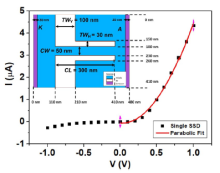Self-Switching Device (SSD) as Terahertz/Microwave detector
| Abstract | SSD was first conceptualized and realized by Song et al. in 2003 utilizing two L-shaped trenches in In0.7Ga0.3As heterostructures. The device working resembles to a diode, however, does not require any doping junctions and/or Schottky barrier to produce non-linear I-V characteristics. The planar architecture of the device, i.e., the electrical contacts are on the same plane as of device, reduces the parasitic effects enabling high frequency operation. The output current, threshold voltage and maximum operating frequency of the device can be easily tuned by adjusting the channel width and length of the SSD, whereas the properties of conventional rectifiers are typically material-dependent. We have demonstrated a In0.53Ga0.47As-based self-switching diode bridge rectifier (SSDBR) based on a zero-bias self-switching diode. The AC and DC characteristics of the SSDBR are presented, demonstrating full wave rectification up to frequencies of 0.240 THz with a noise-equivalent power of 39.90 pW (Hz1/2)−1. In addition, we have demonstrated that Graphene based SSD can be utilised as thermoelectric device to produce DC output. Currently, we are developing a frequency multiplier based on GaN SSD. |
| Faculty |
Arun Kumar Singh
Neena Gupta
Sanjeev Kumar
|
|
arun@pec.edu.in
|
|
| Collaborations | Prof. Aimin Song, University of Manchester, UK ; Prof. Shahrir R Kasjoo, Universiti Malaysia Perlis (UniMAP), Malaysia; Prof. Santanu Mahapatra, IISc Bangalore |
| More Information | DOI: 10.1109/TNANO.2019.2939199; |







